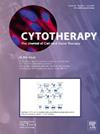Identification of CD141+vasculogenic precursor cells from human bone marrow and their endothelial engagement in the arteriogenesis by co-transplantation with mesenchymal stem cells
IF 3.2
3区 医学
Q2 BIOTECHNOLOGY & APPLIED MICROBIOLOGY
引用次数: 0
Abstract
Background & Aim
Critical limb ischemia (CLI) is a condition characterized by insufficient blood flow to the lower limbs, resulting in severe ischemia and potentially leading to amputation. This study aims to identify novel vasculogenic precursor cells (VPCs) in human bone marrow and evaluate their efficacy in combination with bone marrow-derived mesenchymal stem cells (BM-MSCs) for the treatment of CLI
Methodology
VPCs and BM-MSCs from bone marrow were cultured ex vivo and comparatively characterized, whose therapeutic effects on neovascularization and long-term tissue regeneration were investigated after singular or a combination transplantation in a mouse CLI model
Results
VPCs, expressing high levels of hepatocyte growth factor and c-MET, were identified from human bone marrow aspirates. These cells exhibited strong vasculogenic capacity in vitro but possessed a cellular phenotype distinct from those of previously reported endothelial precursor cells in circulation or cord blood. They also expressed most surface markers of BM-MSCs and demonstrated multipotent differentiation ability. Screening of 376 surface markers revealed that VPCs uniquely display CD141 (thrombomodulin). CD141+VPCs are present in BM aspirates as a rare population and can be expanded ex vivo with a population doubling time of approximately 20 h, generating an elaborate vascular network even under angiogenic factor-deficient conditions and recruiting BM-MSCs to the network as pericyte-like cells. Intramuscular transplantation of a combination of human CD141+VPCs and BM-MSCs at a ratio of 2:1 resulted in limb salvage, blood flow recovery, and regeneration of large vessels in the femoral artery-removed CLI model, with an efficacy superior to that of singular transplantation. Importantly, large arteries and arterioles in dual cell transplantation expressed human CD31 in the intima and human α-smooth muscle actin in media layer at 4 and 12 weeks, indicating their lineage commitment to endothelial cells and vascular smooth muscle, respectively, in vivo.
Conclusion
Dual cell therapeutics comprising human CD141+VPCs and BM-MSCs could be developed for clinical trial to cure human PAD.
人骨髓中CD141+血管形成前体细胞的鉴定及其与间充质干细胞共移植在动脉形成中的内皮作用
背景,急性肢体缺血(aicritical limb ischemia, CLI)是一种以下肢血流不足为特征,导致严重缺血并可能导致截肢的疾病。本研究旨在鉴定人骨髓中新型血管源性前体细胞(VPCs),并评估其与骨髓间充质干细胞(BM-MSCs)联合治疗clii的疗效。方法:体外培养骨髓中新型血管源性前体细胞和骨髓间充质干细胞,比较其在小鼠CLI模型中单独或联合移植后对新生血管和长期组织再生的治疗效果。表达高水平的肝细胞生长因子和c-MET,从人骨髓中被鉴定出来。这些细胞在体外表现出强大的血管生成能力,但具有不同于先前报道的循环或脐带血内皮前体细胞的细胞表型。它们也表达了BM-MSCs的大部分表面标记物,并表现出多能分化能力。对376个表面标记物的筛选显示VPCs独特地显示CD141(血栓调节素)。CD141+VPCs作为一种罕见的群体存在于BM抽吸物中,并且可以在体外扩增大约20小时,即使在血管生成因子缺乏的情况下也能产生复杂的血管网络,并将BM- mscs作为周细胞样细胞招募到网络中。人CD141+VPCs与BM-MSCs按2:1的比例联合肌内移植,在股动脉切除的CLI模型中,肢体保留、血流恢复和大血管再生的效果优于单一移植。重要的是,双细胞移植中的大动脉和小动脉在4周和12周时表达了内膜中的人CD31和介质层中的人α-平滑肌肌动蛋白,表明它们在体内分别向内皮细胞和血管平滑肌传递谱系。结论由人CD141+VPCs和BM-MSCs组成的双细胞疗法可用于治疗人PAD的临床试验。
本文章由计算机程序翻译,如有差异,请以英文原文为准。
求助全文
约1分钟内获得全文
求助全文
来源期刊

Cytotherapy
医学-生物工程与应用微生物
CiteScore
6.30
自引率
4.40%
发文量
683
审稿时长
49 days
期刊介绍:
The journal brings readers the latest developments in the fast moving field of cellular therapy in man. This includes cell therapy for cancer, immune disorders, inherited diseases, tissue repair and regenerative medicine. The journal covers the science, translational development and treatment with variety of cell types including hematopoietic stem cells, immune cells (dendritic cells, NK, cells, T cells, antigen presenting cells) mesenchymal stromal cells, adipose cells, nerve, muscle, vascular and endothelial cells, and induced pluripotential stem cells. We also welcome manuscripts on subcellular derivatives such as exosomes. A specific focus is on translational research that brings cell therapy to the clinic. Cytotherapy publishes original papers, reviews, position papers editorials, commentaries and letters to the editor. We welcome "Protocols in Cytotherapy" bringing standard operating procedure for production specific cell types for clinical use within the reach of the readership.
 求助内容:
求助内容: 应助结果提醒方式:
应助结果提醒方式:


